



Planning & Land Use
Definitions
The terms Government Land Use Planners are quite foreign to regular citizens - worse the terms are not what they appear to be on the surface. Responsible citizens ("trust but verify") need to understand these terms and concepts as they will define (or not) what happens to Ramona in the future.
Here are some selected Planning and Land use definitions of current interest to help you sort things out - please read as many of these as your time allows:
RCPG - Ramona Community Planning Group. This is an elected but un-paid advisory group of Ramona residents that meet formally each month. The RCPG provides advisory community input to the San Diego County Department of Planning and Land Use (DPLU). This fifteen person group elected for four-year terms is intended to provide community input to land use issues and permitting and zoning issues brought before it.
GP 2020 - the proposed guiding plan for future development in San Diego County . Since Ramona is an unincorporated community in the larger San Diego County , the provisions of GP 2020 would govern future development and land use in the area.
The Board of Supervisors recently approved the Circulation Element (see definition below) road network revisions completing the regional mapping efforts for General Plan 2020. The County will them proceed on the remaining phases of the GP 2020 project. Those include the regional land use, housing, circulation, conservation, parks and open space, safety, and noise elements, the community and sub-regional plans, and the draft environmental impact report.
This plan, and the process used to develop are largely unsupported by advisory community planning groups throughout the County . Back in 2005, the Ramona Community Planning Group (RCPG) joined Lakeside , Spring Valley , Alpine and Jamul community planning groups in voicing their formal opposition to the GP 2020.
Smart Growth – this urban planning mandate has widespread support by governmental planning staffs throughout the country. I do not believe this planning mandate is appropriate for the Ramona community. Learn more about it at this link at a website that strongly supports Smart Growth concepts www. smartgrowth.org
In general, smart growth invests time, attention, and resources in restoring community and vitality to center cities and older suburbs. New smart growth is more town-centered, is transit and pedestrian oriented, and has a greater mix of housing, commercial and retail uses.
“Conservation Subdivisions (CSD)” or “Clustering” - This is a planning concept where developers are allowed to build homes on smaller lots if they leave a portion of the land undisturbed as protected open space. For example, if a "traditional" residential zoning ordinance requires a minimum lot size of 10,000 square feet, a 50-acre parcel could yield roughly 200 houses. In contrast, a CSD-friendly zoning ordinance might allow a developer to build the same 200 houses on 5,000 square foot lots if the other half of the land is left undeveloped. Some communities have even adopted incentive-based ordinances that offer density bonuses to developers that utilize CSD, allowing them to build more homes on a given parcel than would have been allowed under traditional zoning.
Follow the money - From the developer's perspective, CSD offers lower development-related expenses. Having homes clustered on smaller lots reduces development costs since there are fewer trees to clear, less land to grade, and less length of road, water, power and sewer infrastructures needed to serve the development.
Many citizens are suspicious of conservation subdivisions/clustering since these “in perpetuity” conservation areas are always subject to future rezoning and future development. Other citizens hold to the premise that land that is privately held especially an area dominated by many smaller acreage parcels are difficult and costly for the government to condemn and then aggregate/combine for large developments or other revenue generating commercial endeavors. See http://www.rppi.org/conservationsubdivision.html for a discussion of CSDs.
Circulation Elements and Level of Service: These terms apply to community roads. Circulation elements are designated routes current and future that serve to define how road construction if resourced will be pursued in a community. Level of Service is a rating of how well the roads work/flow traffic. Roads are rated in a scale from “A” to “F” with F being failing.
Circulation elements along with Land Use Elements typically make up City /Town/ County General Plans. The Circulation Element shows corridors of existing and proposed State highway routes as planned by the California Department of Transportation (CalTrans) in cooperation with the cities and the County as well as depicting routes located within the territories of incorporated cities. The intent of the Circulation Element to preserve a corridor uninhabited by any permanent structure for future road right-of-way for each and every road shown on the Circulation Element also all land developments should conform to the Circulation Element. Generally road matters reflected the Circulation Element shall supersede any proposal of any Community, Subregional, or Development Plan.
Other germane definitions
Representative Democracy - a form of democracy founded on the exercise of popular sovereignty by the people's elected representatives. It is a theory of civics in which voters choose representatives to act in their interests with enough authority to exercise initiative in the face of changing circumstances.

